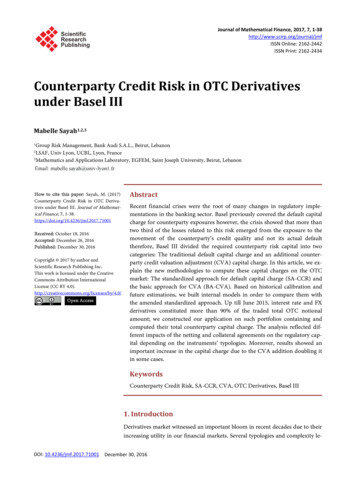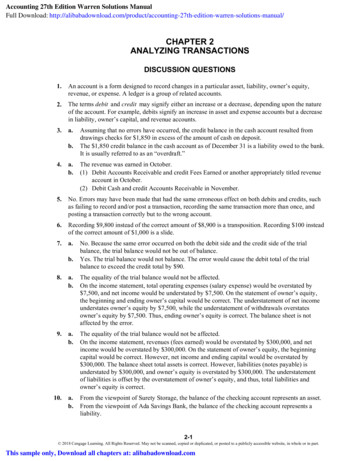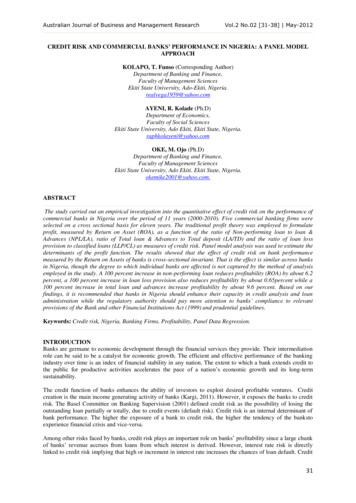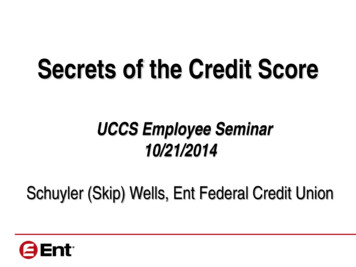
Transcription
The Impact of Credit Risk Management onProfitability of Commercial Banks:A Study of EuropeAuthors:Fan LiYijun ZouSupervisor: Catherine LionsStudentUmeå School of Business and EconomicsSpring semester 2014Degree project, 30 hp
ABSTRACTBanks today are the largest financial institutions around the world, with branches andsubsidiaries throughout everyone’s life. However, commercial banks are facing riskswhen they are operating. Credit risk is one of the most significant risks that banks face,considering that granting credit is one of the main sources of income in commercialbanks. Therefore, the management of the risk related to that credit affects theprofitability of the banks. The aim of the research is to provide stakeholders withaccurate information regarding the credit risk management of commercial banks withits impact on profitability.The main purpose of the research is to investigate if there is a relationship betweencredit risk management and profitability of commercial banks in Europe. We also aimto investigate if the relationship is stable or fluctuating. In the research model, ROEand ROA are defined as proxies of profitability while NPLR and CAR are defined asproxies of credit risk management. The research collects data from the largest 47commercial banks in Europe from 2007 to 2012 and formulates four hypotheseswhich are related to the research question. A series of statistical tests are performed inorder to test if the relationship exists. Other statistical tests are performed toinvestigate if the relationship is stable or not.The findings reveal that credit risk management does have positive effects onprofitability of commercial banks. Between the two proxies of credit risk management,NPLR has a significant effect on the both ROE and ROA while CAR has aninsignificant effect on both ROE and ROA. However, from 2007 to 2012, therelationships between all the proxies are not stable but fluctuating.Key words: Credit risk management, Profitability, Commercial banks, CAR, NPLR,ROA, ROE
ACKNOWLEDGEMENTWe want to thank and express our great gratitude to all those who helped with thecompletion of the thesis. First, we would like to thank our supervisor Catherine Lions,who helped us to overcome many difficulties, and always lead us in the right direction.Additionally, we offer our gratitude to our friends and family that supported usthrough the writing of this research. All of you have contributed to a successful andrewarding writing process.Thank you!Umeå, May 21stFan LiYijun Zou
pulationandSampleData.464.2TimeHorizon.47
TIONOFCAPITALRATIOUNDERBASELII.25
SETS( LRANDROEACROSSYEARS.61FIGURE11 LRANDROEACROSSYEARS(THEP- FFICIENTOFCAR,NPLRANDROAACROSSYEARS(THEP- ‐VALUESAREINTHEBRACKETS).63
ROAROEROCRWABasel Committee on Banking SupervisionCapital Adequacy RatioCoefficientInternational Financial Reporting StandardsInternal Rating-basedNatural Log of Total AssetsNon-performing LoanNon-performing Loan RatioProbability ValueReturn on AssetsReturn on EquityReturn on CapitalRisk-Weighted-Assets
Chapter1IntroductionIn this chapter, we provide the reader with an introduction to our research area. Itstarts with problem background, which presents how we select the research topic, theprevious research and subsequently guides the readers to the research questions. Inthe following we will present with our research purpose, contribution & limitationsand choice of and the chapter will end with the disposition of the research.1.1ProblemBackgroundBanks today are the largest financial institutions around the world, with branches andsubsidiaries throughout everyone’s life. There are plenty of differentiations betweentypes of banks. And much of this differentiation rests in the products and services thatbanks offer (Howells & Bain, 2008, p.34). For instance, commercial banks holddeposits, bundling them together as loans, operating payments mechanism, etc.Commercial banking in virtually all countries has been subject to a great deal ofregulations (Hull, 2012, p.22). One of the regulations is the minimum capitalcommercial banks must keep absorbing loss if unexpected things happen. This kind ofcapital requirement is, in particular, conducted by Basel Committee which aims toenhance the key supervisory issue and improve the quality of banking supervision(Bis.org, 2014). In 1974, some disruptions took place in the international financialmarkets. West Germany’s Federal Banking Supervisory Office withdrew BankhausHerstatt’s banking license after finding that the bank’s foreign exchange exposuresamounted to three times its capital. As a consequence, banks outside Germany tookheavy losses on their unsettled trades with Herstatt. In the same year, the FranklinNational Bank of New York also closed its door after racking up huge foreignexchange losses (Bis.org, 2014). All of these things contributed to the debacle offinancial market which led to the Basel Committee on Banking Regulations andSupervisory Practices by central bank governors of the G10 countries.Latin American debt crisis burst in early 1980’s. Mexico's bank indebtednessexpanded almost 230% over the six-year period from 1976 to 1982, Brazil's 160%,Venezuela's obligations spurted 330%, Argentina's by a monstrous 550% and Chile's850% (Wessel, 1984, p.5). This has attracted the attention of Basel Committee, andthe capital adequacy soon became the main focus of its activities. In December 1987,the capital measurement system called Basel Accord was approved by the G10governors and came into effort in 1988 (Bis.org, 2014). The Basel Accord (Basel I)mainly focused on credit risk and called for a minimum capital ratio of capital torisk-weighted assets of 8% to be implemented by the end of 1992 (Bis.org, 2014). InJanuary 1996, an amendment of Basel 1 was issued with incorporation of a capital1
requirement for the market risks. Later in time, Basel committee was still endeavoringto make the Basel Accord more completed and up-to-date (Bis.org, 2014). So theyreleased a new capital adequacy framework called Basel II in June 2004. Thisframework contained three pillars which we would like to discuss in later chapters.However, the 2007 financial crisis made the Basel committee realized that Basel IIseems not enough in the complicated financial markets. A major overhaul of Basel IIwas necessary. The banking sector had entered the crisis with too much leverage andinadequate liquidity buffers (Bis.org, 2014). These defects were accompanied by poorgovernance and risk management, as well as inappropriate incentive structures. Thecombination of these factors was manifest in the mispricing of credit and liquidity risk,and excess credit growth (Bis.org, 2014). Therefore, a new standard Basel III waspublished in December 2010 and will be fully effective by the end of 2019. Itstrengthened the Basel II framework and made some innovations, including tighteneddefinition of capital, requirements for leverage ratio and a countercyclical buffer, thecapital for liquidity risk and counterparty credit risk as the derivatives had gainedtheir population in 20th century.Credit risk is one of significant risks of banks by the nature of their activities.Through effective management of credit risk exposure banks not only support theviability and profitability of their own business but also contribute to systemicstability and to an efficient allocation of capital in the economy (Psillaki, Tsolas, andMargaritis, 2010, p.873). “The default of a small number of customers may result in avery large loss for the bank” (Gestel & Baesems, 2008, p. 24). It has been identifiedby Basel Committee as a main source of risk in the early stage of Basel Accord.Credit risk is a risk of borrower default, which happens when the counterpart fails topay on time. There can be many reasons for default. One of the most common ones isthe obligor is in a financially stressed situation (Gestel & Baesems, 2008, p. 23-24).Besides, if a borrower with high credit quality has deteriorated profile, it can alsocause credit risk loss to the banks (Gestel & Baesems, 2008, p. 23-24). Banks investin debt of those customers (Gestel & Baesems, 2008, p. 23-24). The price of debt soldmight be lower than the price as the bank bought debt (Gestel & Baesems, 2008, p.23-24). This makes a net loss of banks. However, the loss from the default of the bankdoes not have to be great (Gestel & Baesems, 2008, p. 23-24). It depends on thepercent of recover from obligor and total exposure of banks (Gestel & Baesems, 2008,p. 23-24). And a good risk management tries to avoid high exposure on risk (Gestel &Baesems, 2008, p. 23-24). Although the regulations have been evolutionarilydeveloped, the three Basel Accords all have placed explicitly the onus on banks toadopt sound internal credit risk management practices to assess their capital adequacyrequirement.The strength of the banking industry is an important prerequisite to ensure thestability and growth of economy (Halling & Hayden, 2006, p.48). As a consequence,the assessment of banks’ financial condition is a fundamental goal for regulators(Halling & Hayden, 2006, p.48). Besides, Tabari, Ahmadi and Emami (2013) have2
mentioned “the safety of banking system is depending on the profitability and capitaladequacy of banks. Profitability is a parameter which shows management approachand competitive position of bank in market-based banking. This parameter helps thebanks to tolerate some level of risk and support them against short-term problems.”The profitability of banks is influenced by different factors including management,size, location and time according to a study conducted by Haslem (1968). And it is ofgreat interest to see how the profitability is affected by the risks faced by commercialbanks. There have been lots of researchers devoted into this topic. For example,Bourke (1989) found there exists a positive relationship between liquidity andprofitability of banks in 12 European, Northern American and Australian countrieswhile Molyneux & Thornton (1992) in their study found the two variables arenegatively related. Berger in 1995 in his empirical study surprisingly reported that forU.S. banks in the 1980s, there was a strong positive relationship betweencapital-assets ratio and profitability under the condition he considered the relationshipshould be negative. Several latest researchers have also dug into these topics, Ara,Bakaeva and Sun (2009) have found the positive relationship between credit riskmanagement and profitability of commercial banks in Sweden. Kolapo, Ayeni andOke (2012) showed that credit risk management is positively related to profitability ofbanks in Nigeria. Kithinji (2010) assessed the effect of credit risk management on theprofitability of commercial banks in Kenya and found that banks’ profitability is notaffected by credit risk management. When it comes to both credit risk and liquidityrisk, Ruziqa (2013) has tested the impact of credit risk and liquidity risk on thefinancial performance of conventional banks in Indonesia. The results illustrated thatcredit risk was negatively related to profitability while liquidity risk demonstrated apositive effect. These kinds of researches show that no exact final conclusion could bedrawn until now and thus make this area worth studying.Many forces of change have influenced the competitive environment in Europeanbanking industry. Especially when the adoption of Second Banking Co-ordinationDirective of 1992 as part of the single European market project which removedinstitutional obstacles for banks to operate in foreign countries in EU, theestablishment of Economic and Monetary Union and the introduction of the singlecurrency also had affected the banking industry (Bikker, 1999, p.2). Large andtransparent euro capital markets are emerging. Domestic banks take the advantage forbonds and equity from the crumble trade activities for the loss of national currencieswith euro (Bikker, 1999, p.2). And fund management has no longer been reservedmainly for the local financial institutions (Bikker, 1999, p.2). This internationalintegration and national deregulation have boosted competition in the Europe. Theadoption of the euro began in the early 1990s with the signing of the MaastrichtTreaty (Startfor, 2010). Once the European countries such as Spain, Portugal, Italyand Greece joined the Eurozone, their cost of borrowing has been reduced due to theimplied guarantee that their debt would be as solid as Germany’s government debt(Startfor, 2010). It indicates that those countries can access to credit with lower ratethan the rate based on their own economies (Startfor, 2010). However, this creates3
some housing bubbles in the Europe, especially in Spain and Ireland, which lead tothe relatively high level of private-sector indebtedness (Startfor, 2010). And thisexposure to credit bubbles cause Europe vulnerable to the financial crisis, Swedish,Italian, Austrian and Greek banking systems have expanded into the new markets inCentral and Eastern Europe, and the financial centers of France, Germany,Switzerland, Netherlands and United Kingdom dabbled in the derivatives markets(Startfor, 2010). One particular case of German is the low profit margin generated byhighly fragmented banking system of more than 2000 banks (Startfor, 2010). In thisresearch, we mainly focus on commercial banks in Europe.1.2ResearchquestionAmong other risks faced by banks, credit risk plays an important role on banks’financial performance since a large chunk of banks’ revenue accrues from loans fromwhich interest margin is derived (Kolapo, Ayeni & Oke, 2012, p.31). Based on theinformation we have studied in the previous part, we have realized that it is of greatinterest to study the relationship between credit risk management and profitability ofcommercial banks. And there is no research that could clearly explain the relationshipof credit risk management and profitability of commercial banks. Another factor leadsus to the topic is that research in the Europe, as a complicated and stable financialmarket, has not been developed until now.In order to acquire the knowledge of impact of credit risk management andprofitability of commercial banks, we made the following research question:What is the relationship between the credit risk management and profitability ofcommercial banks in Europe from 2007 to 2012?1.3ResearchPurposeThe main purpose of the research is to analyze how the credit risk management willinfluence the profitability of commercial banks in Europe. To analyze the effect, weneed to find whether the relationship of those two variables exists or not firstly. Themajor issue is the indicators of credit risk management and profitability. We will usecapital adequacy ratio (CAR) and non-performing loan ratio (NPLR) as variables torepresent credit risk management and ROE and ROA as variables to measure theprofitability of commercial banks. When we have found if the relationship truly exists,the next step will be to investigate whether the relationship is positive or negative.Finally, we will test the stability over time of such relationship to find whether therelationship is fluctuating or stable. This kind of test will be conducted on sub-periodsin the chosen time horizon. This will help us to go deep into the research area andcould lead to further research topics in the future.4
1.4ResearchGapandContributionAs we have described before, banks’ strength plays an important role in the stabilityand growth of economy. And the stability of banks depends on the profitability andcapital adequacy (Tabari et al., 2013, p.1624). A thorough study of previous researchrelating the profitability of banks has made us aware of the lacking conclusion ofrelationship between credit risk management and profitability of commercial banks.Most of researchers have focused on one or several countries and showed differentresults. However, no researcher has put the research in Europe. Therefore, we havefound the existence of research gap and devote our effort to conduct a research on it.For a theoretical contribution, our study will fill the research gap on the influence ofcredit risk management to the profitability in commercial banks. And under thecondition that derivative market now is getting increasing popularity. Banks are usingdiversified derivatives (futures, options, and swaps) to hedge counterparty defaultrisks (Jones & Pérignon, 2013, p. 373). Consequently, we can provide morecomprehensive knowledge to the readers. Another contribution will be that thisresearch will supply the foundation for other researchers who wish to dig into furtherstudy of such area, for example, is the geographic variable an influential factor relatedto the stability of the relationship?From a practical perspective, the information provided in this research will offer aguideline for bank managers, investors and bank supervisors, depending on theoutcome of our research. Bank managers could pay more attention to improve banks’performance by managing the credit risk banks face. Banks thus can better arrangeand allocate their resource regarding the position of credit risks. Besides, privateinvestors can have a more comprehensive outlook of how the profitability will beaffected. By evaluating the risk management from the risk report that banks provide,they may have more resources on decision making according to the e
The Impact of Credit Risk Management on Profitability of Commercial Banks: A Study of Europe Authors: Fan Li Yijun Zou . Umeå School of Business and Economics Spring semester 2014 Degree project, 30 hp . ABSTRACT Banks today are the largest financial institutions around the world, with branches and subsidiaries throughout everyone's life. .











